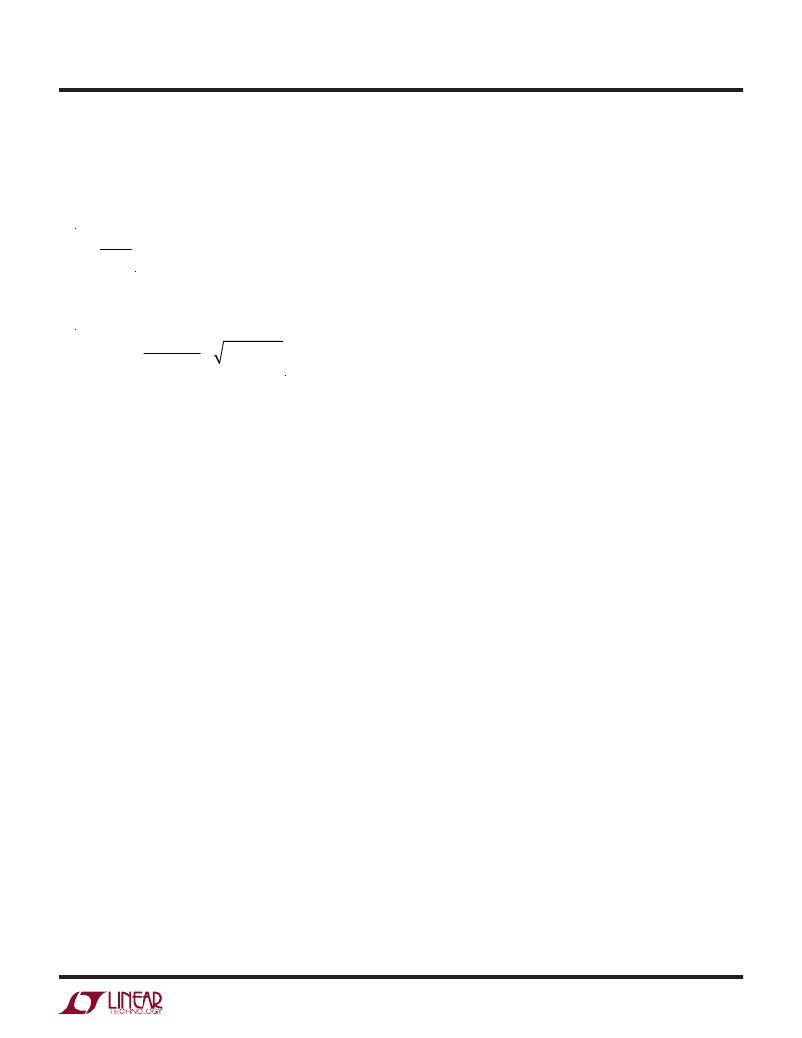- 您现在的位置:买卖IC网 > Sheet目录868 > LTM4608AEV#PBF (Linear Technology)IC BUCK SYNC ADJ 8A 68LGA
�� �
�
 �
�LTM4608A�
�APPLICATIONS� INFORMATION�
�V� OUT�
�?� D� ?� (� 1� –� D� )�
�I� CIN(RMS)� =�
�Iflowimpedancepowerplanesareused,thenthis47μF�
�capacitor� is� not� needed.�
�For� a� buck� converter,� the� switching� duty-cycle� can� be�
�estimated� as:�
�D� =�
�V� IN�
�Without� considering� the� inductor� current� ripple,� the� RMS�
�current� of� the� input� capacitor� can� be� estimated� as:�
�I� OUT(MAX)�
�η� %�
�In� the� above� equation,� η� %� is� the� estimated� efficiency� of�
�the� power� module.� The� bulk� capacitor� can� be� a� switcher-�
�rated� electrolytic� aluminum� capacitor,� polymer� capacitor�
�for� bulk� input� capacitance� due� to� high� inductance� traces�
�or� leads.� If� a� low� inductance� plane� is� used� to� power� the�
�device,� then� only� one� 10μF� ceramic� is� required.� The� three�
�internal� 10μF� ceramics� are� typically� rated� for� 2A� of� RMS�
�ripple� current,� so� the� ripple� current� at� the� worse� case� for�
�8A� maximum� current� is� 4A� or� less.�
�Output� Capacitors�
�The� LTM4608A� is� designed� for� low� output� voltage� ripple�
�noise.� The� bulk� output� capacitors� defined� as� C� OUT� are�
�chosen� with� low� enough� effective� series� resistance� (ESR)�
�to� meet� the� output� voltage� ripple� and� transient� require-�
�ments.� C� OUT� can� be� a� low� ESR� tantalum� capacitor,� a� low�
�ESR� polymer� capacitor� or� ceramic� capacitor.� The� typical�
�output� capacitance� range� is� from� 47μF� to� 220μF.� Additional�
�output� filtering� may� be� required� by� the� system� designer,�
�if� further� reduction� of� output� ripple� or� dynamic� transient�
�spikes� is� desired.� Table� 3� shows� a� matrix� of� different� output�
�voltages� and� output� capacitors� to� minimize� the� voltage�
�droop� and� overshoot� during� a� 3A/μs� transient.� The� table�
�optimizes� total� equivalent� ESR� and� total� bulk� capacitance�
�to� optimize� the� transient� performance.� Stability� criteria� are�
�considered� in� the� Table� 3� matrix,� and� the� Linear� Technology�
�LTpowerCAD?� Design� Tool� is� available� for� stability� analysis.�
�Multiphase� operation� will� reduce� effective� output� ripple� as�
�a� function� of� the� number� of� phases.� Application� Note� 77�
�discusses� this� noise� reduction� versus� output� ripple� cur-�
�rent� cancellation,� but� the� output� capacitance� will� be� more�
�a� function� of� stability� and� transient� response.� The� Linear�
�Technology� LTpowerCAD� Design� Tool� will� calculate� the�
�output� ripple� reduction� as� the� number� phases� implemented�
�increases� by� N� times.�
�Burst� Mode� Operation�
�The� LTM4608A� is� capable� of� Burst� Mode� operation� in� which�
�the� power� MOSFETs� operate� intermittently� based� on� load�
�demand,� thus� saving� quiescent� current.� For� applications�
�where� maximizing� the� efficiency� at� very� light� loads� is� a�
�high� priority,� Burst� Mode� operation� should� be� applied.� To�
�enable� Burst� Mode� operation,� simply� tie� the� MODE� pin� to�
�V� IN� .� During� this� operation,� the� peak� current� of� the� inductor�
�is� set� to� approximately� 20%� of� the� maximum� peak� current�
�value� in� normal� operation� even� though� the� voltage� at� the�
�I� TH� pin� indicates� a� lower� value.� The� voltage� at� the� I� TH� pin�
�drops� when� the� inductor’s� average� current� is� greater� than�
�the� load� requirement.� As� the� I� TH� voltage� drops� below� 0.2V,�
�the� BURST� comparator� trips,� causing� the� internal� sleep�
�line� to� go� high� and� turn� off� both� power� MOSFETs.�
�In� sleep� mode,� the� internal� circuitry� is� partially� turned� off,�
�reducing� the� quiescent� current� to� about� 450μA.� The� load�
�current� is� now� being� supplied� from� the� output� capacitor.�
�When� the� output� voltage� drops,� causing� I� TH� to� rise� above�
�0.25V,� the� internal� sleep� line� goes� low,� and� the� LTM4608A� re-�
�sumes� normal� operation.� The� next� oscillator� cycle� will� turn�
�on� the� top� power� MOSFET� and� the� switching� cycle� repeats.�
�Pulse-Skipping� Mode� Operation�
�In� applications� where� low� output� ripple� and� high� efficiency�
�at� intermediate� currents� are� desired,� pulse-skipping� mode�
�should� be� used.� Pulse-skipping� operation� allows� the�
�LTM4608A� to� skip� cycles� at� low� output� loads,� thus� increasing�
�efficiency� by� reducing� switching� loss.� Floating� the� MODE�
�pin� or� tying� it� to� V� IN� /2� enables� pulse-skipping� operation.�
�This� allows� discontinuous� conduction� mode� (DCM)� opera-�
�tion� down� to� near� the� limit� defined� by� the� chip’s� minimum�
�on-time� (about� 100ns).� Below� this� output� current� level,�
�the� converter� will� begin� to� skip� cycles� in� order� to� maintain�
�output� regulation.� Increasing� the� output� load� current� slightly,�
�above� the� minimum� required� for� discontinuous� conduction�
�mode,� allows� constant� frequency� PWM.�
�4608afd�
�11�
�发布紧急采购,3分钟左右您将得到回复。
相关PDF资料
LTM4608IV#PBF
IC DC/DC UMODULE 8A 68-LGA
LTM4609IV#PBF
IC BUCK/BOOST SYNC ADJ 4A 141LGA
LTM4612IV#PBF
IC BUCK SYNC ADJ 5A 133LGA
LTM4613MPV#PBF
IC UMODULE DC/DC 8A 133-LGA
LTM4614IV#PBF
IC UMODULE DC/DC DUAL 4A 144LGA
LTM4615IV#PBF
IC SWIT REG BUCK 4A ADJ 144LGA
LTM4618IV#PBF
IC DC-DC UMODULE BUCK 6A 84-LGA
LTM4619IV#PBF
IC SWIT REG BUCK 4A ADJ 144LGA
相关代理商/技术参数
LTM4608AEV#PBF
制造商:Linear Technology 功能描述:DC/DC MICRO MODULE IC
LTM4608AEVPBF
制造商:Linear Technology 功能描述:Conv DC-DC Single-OUT Step Down
LTM4608AEV-PBF
制造商:LINER 制造商全称:Linear Technology 功能描述:Low VIN, 8A DC/DC μModule with Tracking, Margining, and Frequency Synchronization
LTM4608AIV#PBF
功能描述:IC BUCK SYNC ADJ 8A 68LGA RoHS:是 类别:电源 - 板载 >> DC DC Converters 系列:µModule® 设计资源:VI-200, VI-J00 Design Guide, Appl Manual 标准包装:1 系列:* 类型:隔离 输出数:1 电压 - 输入(最小):55V 电压 - 输入(最大):100V Voltage - Output 1:5.8V Voltage - Output 2:- Voltage - Output 3:- 电流 - 输出(最大):* 电源(瓦) - 制造商系列:100W 电压 - 隔离:* 特点:* 安装类型:通孔 封装/外壳:9 针半砖 BusMod 尺寸/尺寸:2.36" L x 2.28" W x 1.08" H(59.9mm x 57.9mm x 27.4mm) 包装:散装 工作温度:-25°C ~ 100°C 效率:* 电源(瓦特)- 最大:*
LTM4608AIV#PBF
制造商:Linear Technology 功能描述:DC/DC MICRO MODULE IC
LTM4608AIV-PBF
制造商:LINER 制造商全称:Linear Technology 功能描述:Low VIN, 8A DC/DC μModule with Tracking, Margining, and Frequency Synchronization
LTM4608AMPV
制造商:LINER 制造商全称:Linear Technology 功能描述:Low VIN, 8A DC/DC μModule with Tracking, Margining, and Frequency Synchronization
LTM4608AMPV#PBF
功能描述:IC BUCK SYNC ADJ 8A 68LGA RoHS:是 类别:电源 - 板载 >> DC DC Converters 系列:µModule® 设计资源:VI-200, VI-J00 Design Guide, Appl Manual 标准包装:1 系列:* 类型:隔离 输出数:1 电压 - 输入(最小):66V 电压 - 输入(最大):160V Voltage - Output 1:12V Voltage - Output 2:- Voltage - Output 3:- 电流 - 输出(最大):* 电源(瓦) - 制造商系列:50W 电压 - 隔离:* 特点:* 安装类型:通孔 封装/外壳:9-FinMod 尺寸/尺寸:4.60" L x 1.86" W x 0.79" H(116.8mm x 47.2mm x 20.1mm) 包装:散装 工作温度:-25°C ~ 85°C 效率:* 电源(瓦特)- 最大:*